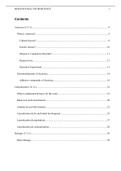Class notes
Lecture Notes - Behavioural Neuroscience
An elaborate document (ca. 120 pages) with notes on all the lectures for behavioural neuroscience. It includes the text from the slides with the comments/explanation from the lecturer for each point. For some lectures (like lateralization or emotion) a lot of what the lecturer said was literally in...
[Show more]
Preview 4 out of 130 pages
Uploaded on
December 3, 2021
Number of pages
130
Written in
2021/2022
Type
Class notes
Professor(s)
Bernd riedstra, bauke buwalda, gertjan van dijk, anton scheurink en sietse de boer
Contains
All classes
brain damage
lateralisation
lateralization
emotion
stress
health
psychiatry
psychiatric disorders
taste and smell
taste
smell
anorexia nervosa
eating disorders
aggression
als
neuroscience
behavioural neuroscience
pinel
Book Title: Biopsychology, ePub, Global Edition
Author(s): John Pinel, Steven Barnes
Edition: Unknown ISBN: 9781292367682 Edition: 1
Class notes
Minor Neuroscience WBBY009-15 College aantekeningen/samenvatting voor tentamen deel 1
Other
Biological Psychology - Example Essays, Lecture notes and Reading Notes (Psychology of Mental Health Conversion course)
Other
Answered Practice questions for Behavioural Neuroscience
All for this textbook (5)
Institution
Rijksuniversiteit Groningen (RuG)
Education
Minor Neuroscience
Course
Behavioural Neuroscience (WBBY01015)
All documents for this subject (3)
By: ivarhesse98 • 3 year ago
$4.81
Also available in package deal from $9.10
100% satisfaction guarantee
Immediately available after payment
Both online and in PDF
No strings attached
Also available in package deal (1)
Studying bundle - behavioural neuroscience
1. Class notes - Lecture notes behavioural neuroscience
2. Other - Practice questions for behavioural neuroscience
3. Other - Answered practice questions for behavioural neuroscience
Show more
BEHAVIOURAL NEUROSCIENCE 1





